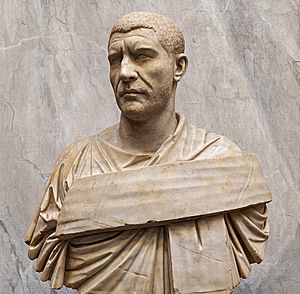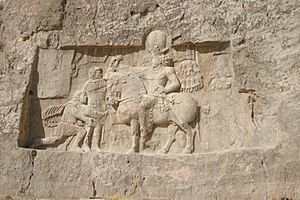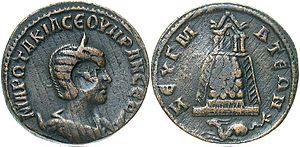Philip the Arab facts for kids
Quick facts for kids Philip the Arab |
|||||||||
|---|---|---|---|---|---|---|---|---|---|

Bust, Vatican Museums
|
|||||||||
| Roman emperor | |||||||||
| Reign | February 244 – September 249 | ||||||||
| Predecessor | Gordian III | ||||||||
| Successor | Decius | ||||||||
| Co-emperor | Philip II (248–249) | ||||||||
| Born | c. 204 Philippopolis, Arabia Petraea |
||||||||
| Died | September 249 (aged 45) Verona, Italia |
||||||||
| Spouse | Marcia Otacilia Severa | ||||||||
| Issue | Philip II | ||||||||
|
|||||||||
| Religion | Uncertain, allegedly Christianity | ||||||||
Philip the Arab (Latin: Marcus Julius Philippus "Arabs"; born around 204 AD, died September 249 AD) was a Roman emperor. He ruled the Roman Empire from 244 to 249. Philip was born in a city that is now part of Syria.
He became emperor after Gordian III died in 244. Philip quickly made peace with the Persian Empire. Then he went back to Rome to get the Senate's approval. During his time as emperor, Rome celebrated its 1,000th birthday! Philip was later betrayed and killed in a battle in 249. This happened during a rebellion led by Decius, who became the next emperor. Philip's five-year rule was quite stable, which was rare for that time.
Some people in the late 3rd and 4th centuries believed Philip was the first Christian emperor. Writers like Jerome and Eusebius said he was Christian. However, today, experts are not sure if he truly was.
Contents
Early Life and Family
We don't know much about Philip's early life. He was born in what is now Shahba, Syria. This city was about 90 kilometers (56 miles) southeast of Damascus. His hometown was later renamed Philippopolis. It was in a region called Aurantis, which was part of the Roman province of Arabia Petraea. Historians agree that Philip was an Arab. His father, Julius Marinus, was a local citizen.
Philip had a brother named Gaius Julius Priscus. Priscus was an important officer in the Praetorian Guard under Emperor Gordian III. In 234, Philip married Marcia Otacilia Severa. She was the daughter of a Roman Governor. They had a son, Philip II, born in 238. They also had a daughter, Julia Severa or Severina.
Becoming Emperor

Philip became important because of his brother Priscus. Priscus was a high-ranking official under Emperor Gordian III. In 243, the head of the Praetorian Guard, Timesitheus, died. Philip then became the new Praetorian Prefect. This meant he and his brother could guide the young Emperor Gordian III.
In February 244, Gordian III died during a war against the Persian king Shapur I. It's debated how Gordian died. Some say Philip was involved in his death. Others say Gordian died in battle. After Gordian's death, Philip became the new emperor.
Philip knew he had to return to Rome to get the Senate's approval. But first, he needed to make peace with Shapur. The peace terms were not too bad. Philip kept some lands the Romans had won. But he had to agree that Roman Armenia was under Persian influence. He also had to pay a huge amount of money to the Persians. Philip quickly made coins saying he had made peace.
Philip sent Gordian III's ashes to Rome. There, he arranged for Gordian to be honored as a god. In Antioch, Philip left his brother Priscus in charge of the eastern provinces. He also gave his brother-in-law, Severianus, control of the provinces of Moesia and Macedonia. Philip arrived in Rome in late 244. The Senate confirmed him as Augustus (Emperor). He made his young son Caesar and his future heir. His wife, Marcia Otacilia Severa, was named Augusta. He also honored his father, Marinus, as a god. Philip also claimed victory over the Persians, even though he had paid them.
His Time as Emperor
Philip worked hard to have good relations with the Senate. He also started a huge building project in his hometown. He renamed it Philippopolis and filled it with statues of his family. He also started new games in Bostra, the capital of Arabia. These games mixed local traditions with Roman ones.
Building the new city and paying the Persians cost a lot of money. Philip also had to pay the army to keep them happy. To get money, he raised taxes. He also stopped paying money to tribes north of the Danube River. These payments usually helped keep the peace. Both of these decisions caused big problems for the empire.
Problems at the Borders
In 245, Philip had to leave Rome. The peace at the borders was breaking down. Tribes like the Carpi crossed the Danube and attacked Roman lands. Philip set up his headquarters in Philippopolis in Thrace. He pushed the Carpi back across the Danube. By 246, he claimed victory over them. Meanwhile, war with Persia started again in 245.
Rome's 1,000th Birthday
Philip returned to Rome by August 247. He spent a lot of money on the biggest event of his rule: the Ludi Saeculares. This was a huge celebration for Rome's 1,000th birthday. Rome was traditionally founded on April 21, 753 BC, by Romulus.
Special coins were made for the event. The celebrations were grand, with games and shows all over the city. In the Colosseum, over 1,000 gladiators fought and died. Hundreds of exotic animals were also killed, including hippos, lions, and giraffes. Philip also made his son a co-emperor during this time.
The End of His Reign
Even with the celebrations, there were still problems. In late 248, Roman soldiers in some provinces rebelled. They were unhappy with the war against the Carpi. They declared a new emperor named Pacatianus. This caused confusion, and other tribes attacked Roman lands. The Goths invaded and attacked cities. Another rebellion started in the East because of high taxes.
Philip felt overwhelmed and offered to step down. But the Senate supported him. A senator named Decius spoke strongly for Philip. Philip was so impressed that he sent Decius to deal with the rebellions and invasions.
Decius stopped the revolt. But the soldiers in the region were still unhappy. In spring 249, they declared Decius their new emperor. Decius then marched his army towards Rome. Meanwhile, Philip's situation got worse. He had money problems and had to make coins with less silver. Riots started in Egypt, which affected Rome's food supply.
Decius tried to make peace with Philip. But Philip's army met Decius near Verona that summer. Decius easily won the battle. Philip was killed in September 249. He either died in the fighting or was killed by his own soldiers. Philip's eleven-year-old son was likely killed with him. His brother Priscus also disappeared.
Was Philip a Christian?
Some old stories say that Philip was the first Christian Roman Emperor. The historian Eusebius wrote that Philip was a Christian. He said Philip was not allowed into Easter services until he confessed his sins. Philip supposedly did this willingly.
However, most historians today believe that Emperor Constantine was the first Christian emperor. They are not sure if Philip was truly Christian. Non-Christian writers of the time don't mention it. Also, during his rule, Philip seemed to follow the traditional Roman state religion. He put images of Roman gods on his coins. Critics think Eusebius might have said Philip was Christian because Philip was tolerant towards Christians.
See also
 In Spanish: Filipo el Árabe para niños
In Spanish: Filipo el Árabe para niños
- Gothic War (248–253)




